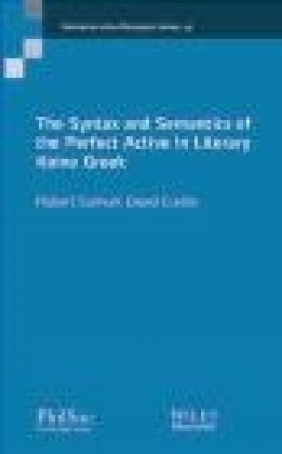The Syntax and Semantics of the Perfect Active in Literary Koine Greek
Robert Crellin
The Syntax and Semantics of the Perfect Active in Literary Koine Greek
Robert Crellin
- Wydawnictwo: John Wiley
- Rok wydania: 2016
- ISBN: 9781119243540
- Ilość stron: 280
- Oprawa: Miękka
Niedostępna
Opis: The Syntax and Semantics of the Perfect Active in Literary Koine Greek - Robert Crellin
The Syntax and Semantics of the Perfect Active in Literary Koine Greek incorporates linguistic insights from both neo-Davidsonian and Chomskyan traditions to present a unified semantic description of the perfect and pluperfect in literary Koine Greek. * Offers a comprehensive and unified account of the Greek perfect that considers its behaviour in terms of tense and aspect, as well as voice (or diathesis) * Features insights from the neo-Davidsonian and Chomskyan semantic traditions while addressing the perfect tense in Koine Greek * Incorporates syntactic and semantic frameworks to provide an account of the perfect in terms of the causative alternation and aspectual classes of predicate * Utilizes a large corpus of material that has not been previously discussed in a linguistic sense relating to the question of the semantics of the Greek perfectIntroduction 1.1 Problem of the Greek perfect active 1.2 Existing frameworks for understanding the perfect 1.3 Existing frameworks for understanding the Greek perfect 1.4 Critical assessment of existing studies 1.5 Aims and approach 1.6 Corpus 1.7 Outline 2. The perfect and lexical aspect 2.1 Introduction 2.1.1 Events and the Greek perfect 2.1.2 The true domain of events 2.1.3 Aspect: semantic, pragmatic or morphological? 2.1.4 Viewpoint aspect, situation aspect and telicity 2.1.5 Tense and aspect in terms of Utterance Time and Topic Time 2.1.6 Viewpoint aspect in Greek 2.1.7 Lexical aspectual categories: Aristotle, Kenny and Vendler 2.1.8 The domain of situation aspect: syntax or lexis? 2.1.9 Developing a lexical aspectual framework for Greek 2.2 Perfect of homogeneous verbs 2.2.1 Introduction 2.2.2 Non-durative state verbs 2.2.3 Durative state verbs 2.2.4 Terminative state verbs 2.2.5 Non-state homogeneous verbs 2.2.6 Conclusion 2.3 Non-durative terminative verbs (describing achievements) 2.4 Non-homogeneous durative verbs (describing activities and accomplishments) 2.4.1 Introduction 2.4.2 Non-COS verbs 2.4.3 COS verbs 2.4.4 Verbs with two perfect active stems 2.4.5 Verbs alternating between COS and non-COS readings without specialised stems 2.4.6 Conclusion 2.5 Noise verbs 2.6 Conclusion 3. Syntactic theoretical frameworks 3.1 Introduction 3.2 Neo-Davidsonian tradition 3.2.1 Event semantics in the Davidsonian tradition 3.2.2 Argument projection in a neo-Davidsonian framework 3.2.3 Semantic roles and grammatical relations 3.2.4 Determining the number of arguments 3.2.5 Formally representing semantic roles in a neo-Davidsonian framework 3.2.6 Are states predicates of eventualities? 3.2.7 Theme hierarchies and thematic proto-roles 3.3 Government-Binding (GB) theory 3.3.1 Introduction 3.3.2 Unaccusativity hypothesis and (causative) change of state 3.3.3 X-bar theory 3.3.4 Status of the subject as a verbal argument 3.3.5 Subject of state sentences 3.3.6 Combining Davidsonian semantics with GB theory 3.4 Predicate types 3.4.1 Introduction 3.4.2 State predicates 3.4.3 Change of state and causative change of state 3.4.4 Change of state and change of location 3.4.5 Accomplishment predicates 3.4.6 Activity predicates 3.5 Voice alternations and the resultative 3.5.1 Passive voice 3.5.2 Resultative 3.5.3 The middle 3.6 Conclusion 4. The causative alternation 4.1 Introduction 4.1.1 Transitivity in traditional Greek grammar passive 4.1.2 The function and development of the Greek middle and passive 4.1.3 Voice and argument projection in Greek 4.1.4 Transitivity and the Greek perfect 4.2 Labile transitivity outside of the perfect 4.2.1 Introduction 4.2.2 Verbs fully participating in the causative alternation 4.2.3 Anticausative denoted by infl ection 4.2.4 Anticausative perfective with a root stem 4.2.5 Semantic distinction determining participation in the causative alternation 4.2.6 Conclusion 4.3 Labile transitivity in the perfect 4.3.1 Introduction 4.3.2 Causative/anticausative distinctions in the perfect 4.3.3 Re-expression of external cause argument by means of an adjunct phrase 4.3.4 Productivity of the specialised causative/anticausative perfect stems 4.3.5 Implications for the meaning of the perfect 4.4 Conclusion 5. The interaction of the perfect with different predicate types 5.1 Introduction: tense and aspect in a neo-Davidsonian framework 5.1.1 Approach 5.1.2 Aspectual Interface Hypothesis (AIH) 5.1.3 Situation aspect 5.1.4 Tense and aspect in a Government-Binding (GB) and neo- Davidsonian framework 5.1.5 Constructing the path of an event 5.1.6 Role of VAspP 5.1.7 Resultative and perfect in English 5.1.8 Outline of the present chapter 5.2 Homogeneous eventualities 5.2.1 Non-durative predicates 5.2.2 Durative predicates 5.2.3 Conclusion 5.3 Non-homogeneous non-COS eventualities 5.3.1 Introduction 5.3.2 Activity predicates 5.3.3 Accomplishment predicates 5.3.4 Conclusion 5.4 COS accomplishment predicates 5.4.1 Introduction 5.4.2 Unaccusative and anticausative predicates 5.4.3 Causative COS predicates 5.4.4 Unaccusativised activity predicates 5.4.5 Delimiting the post-state 5.5 COS achievement predicates 5.5.1 COS predicates 5.5.2 Causative COS predicates 5.6 Conclusion 6. The interaction of the perfect with COS predicates 6.1 Introduction 6.2 Extent predicates 6.2.1 COS and extent predicates 6.2.2 Achievements in a difference scale framework 6.2.3 Non-COS extent predicates 6.2.4 Disambiguation of extent and temporal readings 6.2.5 Viewpoint aspect and difference scales 6.2.6 Tense and extent predicates 6.2.7 The resultative construction 6.2.8 Extent predicates in Greek 6.2.9 Implications for the semantics of the perfect 6.3 Temporal versus extent readings of perfect predicates 6.3.1 Introduction 6.3.2 Prestate not logically present in time 6.3.3 Prestate logically present in time 6.3.4 Metaphorical extension of extent predicates to non-distance scales 6.4 Suppression of the internal argument in non-causative COS predicates 6.5 Suppression of the external argument 6.6 A special case 6.7 Conclusion 7. Deriving homogeneous atelic eventualities from states and non-states 7.1 Introduction 7.2 Deriving a homogeneous atelic eventuality by negation 7.3 Telic state predicates 7.4 Activity predicates 7.5 Non-COS accomplishment predicates 7.6 Causative COS predicates 7.7 Deriving states from states: the perfect of atelic state predicates 7.7.1 Introduction 7.7.2 Pure state predicates 7.7.3 Continued state predicates 7.7.4 COS predicates 7.8 Obligatory anteriority in derived states 7.9 Semantic contribution of the Greek perfect 7.10 Tense and the time adverbial problem 7.11 Noise predicates 7.12 Conclusion 8. Conclusion: the semantics of the Greek perfect
Szczegóły: The Syntax and Semantics of the Perfect Active in Literary Koine Greek - Robert Crellin
Tytuł: The Syntax and Semantics of the Perfect Active in Literary Koine Greek
Autor: Robert Crellin
Wydawnictwo: John Wiley
ISBN: 9781119243540
Rok wydania: 2016
Ilość stron: 280
Oprawa: Miękka
Waga: 0.41 kg























